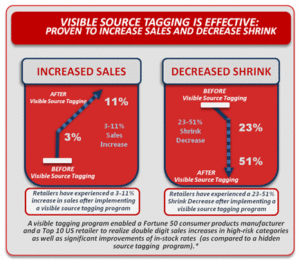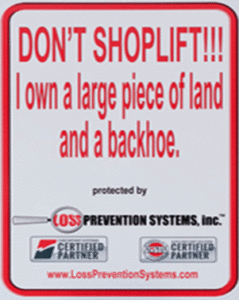Retailers around the world lose billions a dollars every year due to shoplifting and employee theft. And while the big retail chains can financially deal with the problem, there are many small businesses that cannot afford it, nor can they fight it for long.
The laws concerning shoplifting vary by state, and therefore you have to be aware of the steps you need to do while apprehending a shoplifter or an employee caught stealing. Prevention and safety should be some of the most important steps when dealing with shoplifting in your business.
To read more about this and other stories about shoplifting, follow the links below.
To stop a thief: Shoplifting is a daily battle for retailers
On any given day, more than $35 million worth of merchandise is stolen from retail stores across the country by shoplifters – amateurs and professionals alike – who steal clothing, jewelry, electronics and a host of other items, including food.
Some sneak quickly and quietly with the merchandise, others make bold getaway attempts.
In Tupelo, the retail and financial hub of Northeast Mississippi, the Tupelo Police Department gets hundreds of reports each year.
In 2014, TPD took 483 reports related to shoplifting, according to TPD Public Information Officer Chuck McDougald. Last year, that number fell to 260. So far this year, the department has taken 162 calls.
“Higher shopping volume days correspond to more shoplifting calls,” he said. “Those include weekends and holidays.”
As for the timing of when shoplifters are busiest, apparently they’re not early risers.
The nation’s largest retailer is taking justice into its own hands.
The Walmart Supercenter in Camden, S.C., is a 24/7 retail oasis in an area with few options. There are Walmarts in nearby counties, but some of them aren’t open 24 hours a day. Camden’s location—close to Lake Watertree and a nearby river with few bridges—makes it difficult for residents to go anywhere other than the sprawling complex for everything from bread to tires to electronics. And it’s a place the Camden Police Department knows well. In the first six months of 2016, 14% of the department’s police reports originated at Walmart, most for shoplifting—a figure that could be much higher if you ask the town’s police chief.
“Sometimes they don’t call us,” says Camden Police Chief Joe Floyd. “They call us when they make an apprehension of a shoplifter. But they don’t call us every time something happens there.”
Police Officer Found Guilty Of Manslaughter In Shooting Of Unarmed Black Man
Stephen Rankin becomes one of the rare officers convicted of murder or manslaughter for on-duty conduct.
A white Virginia police officer was convicted of voluntary manslaughter Thursday in the fatal shooting of an unarmed black 18-year-old accused of shoplifting.
A circuit court jury found former Portsmouth police officer Stephen Rankin guilty for the killing of William Chapman in April of last year. It was the second time Rankin had killed an unarmed man while on duty. He now faces up to 10 years in prison, although the jury recommended just 2 1/2 years.
Earlier on Thursday, lawyers for Rankin had unsuccessfully urged the judge to declare a mistrial, citing video evidence showing a friend of Chapman’s family speaking to a juror. Rankin’s defense described this as a deliberate attempt to influence the outcome of the trial ― a charge that the friend denied.
Rankin, who was fired while he awaited trial, had originally been charged with first-degree murder and using a firearm to commit a felony.



 a good example using one of the newer clear, Checkpoint Systems stock labels. The trademarked “lock” and wording has been tested extensively.
a good example using one of the newer clear, Checkpoint Systems stock labels. The trademarked “lock” and wording has been tested extensively.

 How do I approach a shoplifting incident? This question is asked of me almost on a daily basis by store managers and owners. We always give advice and best practices on how to deter a shoplifter by using EAS devices, but what should you actually do if you are faced with a shoplifting incident that you personally witness? When should you call the police? When can you legally detain someone? While not every situation is the same, there are some basic best practices to follow. Here’s what I train my managers and can be a great starting point for you.
How do I approach a shoplifting incident? This question is asked of me almost on a daily basis by store managers and owners. We always give advice and best practices on how to deter a shoplifter by using EAS devices, but what should you actually do if you are faced with a shoplifting incident that you personally witness? When should you call the police? When can you legally detain someone? While not every situation is the same, there are some basic best practices to follow. Here’s what I train my managers and can be a great starting point for you. It’s a normal day at the office. I’m working on a few cases and an email comes across from a manager at one of my stores. There’s not much to it; just says “John” called the store looking for you, here’s his number. Curious to who John is, I immediately give him a call. In my mind I’m thinking it could be a detective, or an Assistant District Attorney maybe.
It’s a normal day at the office. I’m working on a few cases and an email comes across from a manager at one of my stores. There’s not much to it; just says “John” called the store looking for you, here’s his number. Curious to who John is, I immediately give him a call. In my mind I’m thinking it could be a detective, or an Assistant District Attorney maybe.
 The amount of calls reported by Walmart stores to the local police are staggering.
The amount of calls reported by Walmart stores to the local police are staggering.